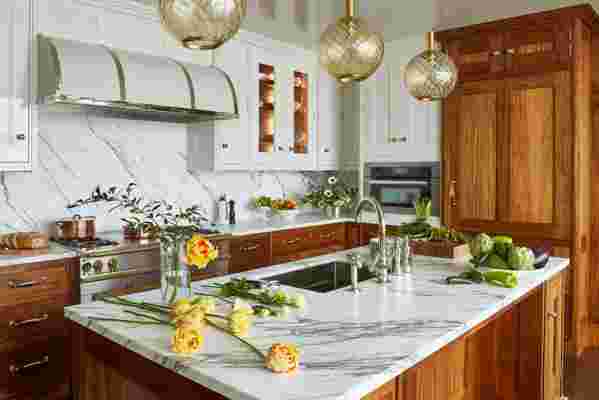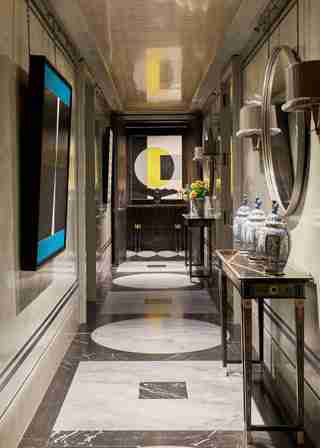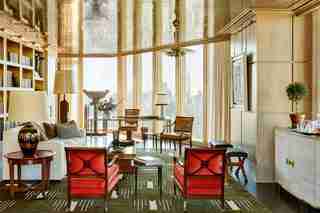Purchasing a home in a brand-new high-rise has all of the benefits you might expect: Everything in pristine and untouched condition, first-rate amenities, and the chance to customize the space to your liking. But for a certain type of buyer, it has one drawback—every unit in the building has pretty much the same features and finishes as the others.
So when you want your home to feel truly unique, as one discerning client did after purchasing an expansive top-floor unit in a new-construction tower in New York City, you have to peel back the developer-provided layers and prepare to rebuild. “He wanted to make sure that everything was top of the line,” interior designer Alexander Doherty says of his client, who gamely proposed to “rip everything up and start from scratch,” as the creative recalls.
For the New York– and Paris–based designer, this brief provided the ultimate opportunity to sculpt a refined, warm interior out of a contemporary glass box—an undertaking that took a great deal of architectural finessing. First, the team that included architect Danielle Albert and contractor Stephen Fanuka reworked the layout by knocking out two of the unit’s four bedrooms and one of its bathrooms, making way for an extended living space and library. To increase the living room’s height, they removed all the ductwork and pushed it out to the sides of the room. This allowed them to create a lake-like depression in the ceiling, covered in gold leaf, that both enlarges the space and adds a striking glimmer. A non-working fireplace was put in to provide a visual focal point. “Then it’s not just sitting on the sofa looking at the views,” Doherty says.
To further shake off the developer feeling, Doherty added custom paneling to every surface of the home in order to create an interior shell more akin to the prewar apartments he normally works on. Crown molding and carefully crafted millwork give historical weight to the residence, as redoing the walls, floors, and ceilings served as a way for the designer to introduce the most premium materials he could get his hands on. Along with the living room’s cerused oak paneling, the apartment boasts surfaces covered in Venetian plaster, high-gloss lacquer, gold leaf, palladium, Italian marble, velvet, and mosaic tile. In one standout moment, a vestibule connecting the bedrooms to the rest of the apartment is clad in black straw marquetry. The entire space was handcrafted by Jallu Ébénistes in France and shipped to the U.S., where it was assembled by the artisans on site.

Christopher Peacock designed the kitchen cabinetry, which features lower cabinets in walnut and upper cabinets in high-gloss paint surrounding a La Cornue range. Three Murano glass pendants from the 1940s hang overhead.
As for the furnishings, Doherty wanted to channel a specific style that wouldn’t feel out of place in a contemporary structure. “The only historical style that I could really see working in a glass tower that was built yesterday in New York is something that harks back to 20th-century modernism—anything ranging from the 1920s almost to 1950s,” he says. The client wasn’t especially familiar with this period, but he remained open-minded, and the designer set about acquiring Art Deco and modernist pieces from Paris galleries and international auction houses. A set with a sofa, two armchairs, and a table by André Arbus was selected for the primary bedroom, while other French designers of the same period—such as Jules Leleu and Jacques Adnet —are also represented. Gio Ponti mirrors, suspended by chains so as not to cut into the custom walls, are scattered throughout the residence.
Key upholstered pieces were made by Jonas to provide a dose of modern-day comfort. “Not-precious” fabrics and large-scale rugs bring warmth, Doherty explains, ensuring that the apartment—despite its period theme—doesn’t feel like a museum. “The idea of having a sectional [sofa] immediately takes away that stiff formality,” he says. To that end, the homeowner, passionate about engineering, was keen on getting all the mechanicals just right. “A quiet AC system, windows that really close so you don’t hear the howl of the wind… The client was on board for better and better and better,” Doherty says.
After three years of work, the behind-the-scenes and the front-of-house ultimately merged to form a dwelling that’s a far cry from a typical spec home. “I was so fortunate in working with this client,” Doherty says. “He’s the only person I’ve ever met who said to me, ‘If during the process you get a better idea, do it. I am on board.’”

The apartment’s front hallway was stripped down and rebuilt with venetian plaster walls and a white gold leaf ceiling. Artgroove is responsible for these and other high-end finishes in the apartment. At the end of the corridor, a black straw marquetry corridor was custom made by Jallu Ébénistes in France.

Designer Alexander Doherty looked to modernist and Art Deco designs from the 1920s through 1950s to furnish the apartment, which is located in a new high-rise in Manhattan. “You have to respect the architecture of the building,” he says. “Otherwise you’re going to end up with something that looks like Disneyland.” In the library that doubles as an office, a pair of Maison Jansen chairs form a seating area with a sofa by Jonas , a 1930s coffee table by Dominique , and André Arbus ottomans. A Jules Leleu chair pulls up to a desk by Marc du Plantier . Hanging from the ceiling—which features a tobacco-colored venetian plaster surface with a double 24-carat gold band around the edge—is a FontanaArte pendant.
The design team extended the height of the ceiling by moving the ductwork to the sides of the room and creating a lake-like depression, lit up by 24-carat gold leaf, in the middle. Cerused oak paneling created by Charles Cimmino Woodwork covers the walls. A non-working fireplace made by Chesneys sits underneath what looks to be a mirror, but is actually a television by Séura . Sofas and an armchair made by Jonas are adorned with de Le Cuona pillows and joined by a Jacques Adnet coffee table and Süe et Mare ottomans on top of a 1930s French rug.
In a bathroom off the library, Guatemala Verde marble with a Belgian Black stone band backdrops a custom shower and a vanity, which was made by Waterworks in antique walnut with brass detailing. The mirror is by Gio Ponti , and the sconces are a French vintage design from the 1930s.
Christopher Peacock designed the kitchen cabinetry, which features lower cabinets in walnut and upper cabinets in high-gloss paint surrounding a La Cornue range. Three Murano glass pendants from the 1940s hang overhead.
The walls of the primary bedroom are upholstered in a Holland & Sherry fabric. The headboard is a custom silk velvet design. A silk rug by Stark adds to the soft gray-and-lilac palette. Over the 1930s French chaise hangs a Swedish light fixture from the 1950s. The bedside tables—French rosewood designs from the ’30s—sit below artworks by Esteban Vicente and James Brooks.
A wall previously blocked the view from the sinks, so the design team cut out as much of the wall as possible, leaving two columns behind for structural support. Now, two Murano mirrors by Venini stationed above a custom vanity fitted with Waterworks fixtures don’t get in the way of the jaw-dropping vistas. Statuary marble is used throughout. “We got it from Italy. As you can imagine by the size of the bathroom, it did require an awful lot [of stone],” Doherty says.
In order to apply the same marble to the shower and steam room, Doherty says, “We had to do a special honeycomb version of it to make it much lighter and attach it to the ceiling.” The sconce is by Jules Leleu.
In the guest bedroom, Doherty had wall panels made in a crushed velvet by de Le Cuona . The headboard, a design by NY Custom Furnishings using Holland & Sherry fabric, carries through the Art Deco theme. The mirror is by Gio Ponti .
Wrapped in black Venetian plaster with a black Portoro marble feature wall, the powder room features a special niche displaying a bronze statue by Kelli Bedrossian . The mirror is by André Arbus , and the sconce is a Jules Leleu design. A faucet from Waterworks’ R.W. Atlas line pairs with a sink cut out of marble.
Mosaic tile from Waterworks decorates the guest bathroom. “That vanity was absolutely the only thing that we kept out of the whole apartment that the developer provided,” Doherty says. They added a marble countertop, a Waterworks medicine cabinet, and French sconces from the 1930s.

Leave a Reply